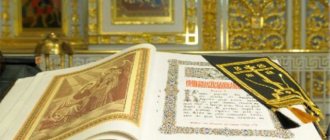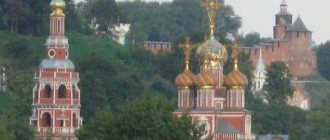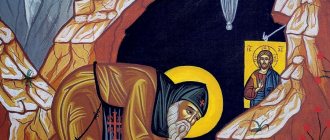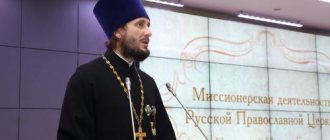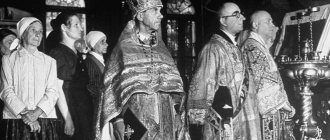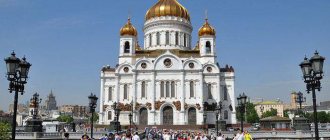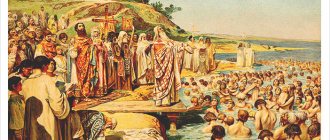The Irkutsk and Angarsk diocese is a diocese of the Russian Orthodox Church. Established in December 1706 as a vicariate of the Tobolsk Metropolis with the title of suffragan bishop of Irkutsk and Nerchinsk. It was in effect until October 6, 2011, when the Irkutsk and Angarsk Metropolis was created instead of the Irkutsk and Angarsk diocese. It united parishes and monasteries in the Irkutsk region. Territorially it belonged to Eastern Siberia and the Siberian Federal District. The diocese included: Irkutsk region and Ust-Orda Buryat cultural autonomy, 31 districts, 22 cities and 60 villages. The ruling bishop is Archbishop Vadim (Lazebny), at the cathedra since February 4, 1990.
History of the Irkutsk diocese (until the 1940s)
In the 17th century, Tobolsk bishops were in charge of religious affairs in Eastern Siberia. Then it was decided to form the Irkutsk Vicariate, covering the territory west and east of Lake Baikal. However, Bishop Varlaam, who arrived in Irkutsk in 1707, left for Moscow two and a half years later without receiving legal and financial support.
In 1727, the Irkutsk diocese was established, which changed its borders many times. In the 30s of the 18th century its borders extended from the Yenisei to the Pacific Ocean. In 1796, the territory of Alaska and the Aleutian Islands was included in the Irkutsk diocese, where the suffragan bishop was supposed to be located. In 1824 the Irkutsk diocese was expanded to the western borders of the Yenisei province. Until 1834, when the territory of the Yenisei province was included in the Tomsk diocese, the Irkutsk diocese. occupied a huge area equal to approximately half of the entire Rossiya. empires. In 1840 the diocese of Kamchatka, Kuril and Aleutian was formed, and the size of the Irkutsk diocese was again reduced. In 1852, the Yakut region and the Irkutsk diocese were annexed to it. began to operate within the borders of the Irkutsk province and the Transbaikal region.
In 1894, the Transbaikal diocese was established and the Irkutsk diocese began to serve only the province of the same name.
The first church in the Angara region was built in the Bratsk fort in the year of its foundation (1631). In 1727 there were 43 churches on the territory of the future diocese. In 1863 there were 229 churches in the diocese. Of these, 121 are in the Irkutsk province and 108 in Transbaikalia. In 1914, in the Irkutsk province (and Irkutsk diocese) there were 223 churches, they were divided into 20 deaneries. In the middle of the 19th century there was one church for every 543 people, and in 1917 for every 332.
The Irkutsk diocese gave 3 saints: the first bishop (1727–1731) Innokenty Kulchitsky, bishop (1754–1771) Sophrony of Kristallevsky, Moscow and Kolomna Metropolitan (from 1868 to 1879) Innokenty Veniaminov. In total, the Irkutsk diocese was ruled by 17 bishops until 1918.
The clergy created a network of educational institutions. In 1825, the first school in Eastern Siberia was opened at the Ascension Monastery - Mungal, and later - Russian-Mungal. Since 1780, the Irkutsk Theological Seminary has been operating - the first secondary educational institution in Eastern Siberia. In the middle of the 19th century, there were 5 theological schools and 36 parish schools in the Irkutsk diocese (14 of them in the Irkutsk province). At the beginning of the 20th century, a seminary, a church-teachers' seminary, and a women's school operated in the Irkutsk diocese. In 1913, the number of parochial schools reached 229, and there were 7,593 students in them.
The level of training of priests gradually increased. In 1832, priests with seminary education made up a quarter of the total, and in the middle of the 19th century - almost 90%. At the beginning of the 20th century, among the priests there were persons with higher education.
The clergy of the Irkutsk diocese was actively involved in missionary activities. “Newly baptized Buryats” near Irkutsk are mentioned in the 1690s. The number of representatives of indigenous peoples who converted to Orthodoxy was approximately 500 people at the end of the 17th century, 50 thousand at the end of the 18th century (Buryats, Yakuts, Kamchadals, Aleuts, etc.). By 1824, almost the entire population of Yakutia had converted to Christianity. In 1908, the Irkutsk mission had 24 camps. In the 18th – first half of the 19th century, the church and secular administration often used material incentives and sometimes violent measures to Christianize the indigenous population. In these cases, the indigenous population accepted Orthodoxy formally, based mainly on material reasons. Nevertheless, even then baptism had some positive consequences. The clergy of the Irkutsk diocese in 1819 published the first book in the Yakut language - “Abridged Catechism”; in 1824–1836 the most important liturgical texts were translated for the population of Russian America; in the 1840–1850s, similar texts were translated into the Buryat language.
Despite the reduction in the size of the Irkutsk diocese, Irkutsk retained its role as a major religious center. This was facilitated by the presence in the Ascension Monastery of the relics of the only saint in Siberia legitimized by the Synod - Innocent. The bishop was assisted by two suffragan bishops - Selenginsky (1862–1894) and Kirensky (from 1883). Here, the Irkutsk Diocesan Gazette was the first to be published in Siberia. Of the 19 Siberian monasteries, 4 were located in the Irkutsk diocese (Voznesensky, Znamensky, Vladimirsky, Kirensky Trinity). In 1894, the Kazan Cathedral was erected, accommodating 5 thousand people.
Irkutsk was, along with Tobolsk, one of the two most important centers of icon painting in Siberia. The cult of Innocent Kulchitsky and religious processions became widespread. The changes associated with the February Revolution were met by the Irkutsk clergy mostly approvingly. After the end of the civil war, the Irkutsk clergy was subjected to physical and moral terror, all monasteries and many churches were closed. (See also: Anti-religious campaign in Irkutsk (20–30s XX).
Irkutsk Historical and local history dictionary. — Irkutsk: Sib. book, 2011.
On October 6, 2011, instead of the Irkutsk and Angarsk diocese, the Irkutsk and Angarsk Metropolis of the Russian Orthodox Church was created.
Years of disbelief
But then the era of atheism began, huge administrative units of the Orthodox Church began to simply be abolished, and churches and monasteries were subjected to plunder and destruction. There is not a single religious institution left on Siberian soil and the Far East. From 1917 to 1930, the Irkutsk diocese, which was not closed, absorbs the lands of the abolished structures, and its size again reaches the Far Eastern shores. However, under pressure from godless sentiments, the authorities closed this diocese too, although not for long - already in 1943 it was restored. Until the last years of Soviet power, the Irkutsk Orthodox diocese extended to the shores of the Pacific Ocean.
Bishops
Irkutsk and Nerchinsk Vicariate of the Tobolsk Metropolis
- Varlaam (Kossovsky) (15.XII.1706-21.I.1714)
Irkutsk diocese
- Ignatius (Smola) (8.IX.1721 - 1.X.1721)
- Innokenty (Kulchitsky) (8.VIII.1727 - 26.XI.1731)
- Innocent (Neronovich) (25.XI.1732 - 26.VII.1747
- Sophrony (Kristalevsky) (18.IV.1753 - 30.III.1771)
- Mikhail (Mitkevich) (2.VIII.1772 - 1.VIII.1789)
- Veniamin (Bagryansky) (9.IX.1789 - 8.VI.1814)
- Mikhail (Burdukov) (18.IX.1814 - 5.VI.1830)
- Irinej (Nesterovich) (Serb 26.VII.1830 - 18.V.1831)
- Meletiy (Leontovich) (18.VI.1831 - 22.VI.1835)
- Innokenty (Alexandrov) (22.VII.1835 - 23.IV.1838)
- Neil (Isakovich) (23.IV.1838-24.XII.1853)
- Afanasy (Sokolov) (24.XII.1853-3.XI.1856)
- Eusebius (Orlinsky) (3.XI.1856-29.VIII.1860)
- Parfeniy (Popov) (13.IX.1860-21.I.1873)
- Veniamin (Blagonravov) (31.III.1873-2.II.1892)
- Macarius (Darsky) (1892) v/u, ep. Selenginsky
- Tikhon (Danebin-Troitsky) (28.III.1892 - 29.VI.1911)
- Seraphim (Meshcheryakov) (VII.25.1911 - XII.11.1915)
- John (Smirnov) (II 26.I.1916 - 16.XII.1918)
- Zosima (Sidorovsky) (XII 20, 1918 - 1920)
- Jacob (Pyatnitsky) (May 29 - July 12, 1920)
- Anatoly (Kamensky) (July 12, 1920 - July 14, 1922, 1923 - February 1, 1924)
- Gury (Stepanov) (February 1924 - December 10, 1925)
- John (Bratolyubov) (July 23 - August 17, 1924) v/u, bishop. Berezovsky
- Irakli (Popov) (1925-1926) high school bishop. Kirensky
- Eusebius (Rozhdestvensky) (1926-1927, bishop of Yeisk)
- Cyprian (Komarovsky) (15.IX.1927-7.V.1929 v/u, bishop of Nizhny Neudinsk
- Barsanuphius (Luzin) (7.V.1929-8.VII.1930)
- Dionysius (Prozorovsky) (8.VII.1930)-16.VI.1933
- Pavel (Pavlovsky) (24.VI.1933-IX.1937)
- Philip (Stavitsky) (XI.1943-1943)
- Bartholomew (Gorodtsov) (26.II.1943-3.VI.1948, archbishop of Novosibirsk and Barnaul
- Yuvenaly (Kilin) (3.VI.1948-21.II.1949)
- Palladium (Sherstennikov) (21.II.1949-20.II.1958)
- Veniamin (Novitsky) (February 21, 1958 - May 31, 1973)
- Vladimir (Kotlyarov) (May 31, 1973 - April 17, 1975)
- Serapion (Fadeev) (April 17, 1975 - April 24, 1980)
- Methodius (Nemtsov) (April 27, 1980 - July 16, 1982)
- Yuvenaly (Tarasov) (July 16, 1982 - December 26, 1984)
- Chrysostom (Martishkin) (December 26, 1984 - January 26, 1990)
- Vadim (Lazebny) (from February 4, 1990)
Znamenskaya monastery
Famous people are buried in the necropolis of the monastery, for example, Princess Ekaterina Trubetskaya and her children - Sophia, Vladimir and Nikita. Kolchak was shot near the monastery. In 2004, a monument was erected here in honor of this great ruler and admiral. At the foot of the wall facing south, the writer Valentin Rasputin was buried in 2015. Throughout the years of the monastery's life, the nuns-gold-sewmakers and seamstresses brought it fame; their skills were known and appreciated even in both Russian capitals.
Cathedrals of the Irkutsk and Angarsk diocese
| Cathedral | Dedicated | Location | A comment |
| Spasskaya Church | Savior Not Made by Hands | Irkutsk, Public Garden | Chair of the Vicariate of the Tobolsk Metropolis from 1706 to 1746 |
| Cathedral of the Epiphany | Epiphany | Irkutsk, Nizhnyaya embankment street | Cathedral from 1746 to 1894 |
| Kazan Cathedral | Kazan Icon of the Mother of God | Irkutsk, Kirov Square | Cathedral from 1894 to 1920. Demolished in 1934 |
| Church of the Exaltation of the Cross | Exaltation of the Holy Cross | Irkutsk, Lenin street | Performed the functions of the Cathedral in 1929-1936 and 1948-1991 |
| Znamensky Cathedral | Holy Mother of God | Irkutsk, Angarskaya street | Main cathedral of the diocese since 1991 |
| Holy Trinity Cathedral | The Holy Trinity | Angarsk, Tchaikovsky street | Second cathedral of the diocese since 2006 |
Monasteries
- Irkutsk Vladimir (inactive)
- Irkutsk Voznesensky (inactive)
- Irkutsk Znamensky (women's)
- Ust-Kirensky Trinity (inactive)
Previously subordinate dioceses
- Nerchinsky Uspensky (inactive, now within the Nerchinsk diocese)
- Ambassadorial Preobrazhensky (male, now within the Ulan-Ude diocese)
- Selenga Trinity (male, now within the Ulan-Ude diocese)
- Tunkinskaya Nilova Hermitage (inactive, now within the Ulan-Ude diocese)
Orthodox dioceses. Read on Irkipedia:
- Sayan and Nizhneudinsk diocese (Russian Orthodox Church)
- Bratsk and Ust-Ilimsk diocese (Russian Orthodox Church)
- Irkutsk-Amur and the entire Far East diocese (Russian Orthodox Old Believer Church)
- Irkutsk renovation diocese (1922–1938)
- Irkutsk diocese in the 1940s-1980s. // Smolina I.V.
New times
Perestroika begins, the Orthodox Church begins its epoch-making revival. The process of resurrection of everything abolished and destroyed is underway. In 1988, the Khabarovsk see was restored and separated, in 1993 the Yakut diocese became independent, in 1994 – the Chita diocese. Again the moment came when the borders of the Irkutsk region and, in fact, the diocese coincided. However, already on October 5, 2011, the Sayan and Bratsk dioceses left its composition and gained independence. And on October 6, a metropolis is formed within the borders of the Irkutsk region, the head of which becomes the Irkutsk bishop.
Literature
- Sokolov N., Pivovarov B. A brief outline of the history of the Irkutsk diocese // Journal. Moscow patriarchy. - 1977. - No. 12.
- Naumova O. E. Irkutsk diocese: XVIII – 1st half. XIX century - Irkutsk, 1996.
- Sannikov A.P. Church administration of Eastern Siberia at the end. XVII – mid. XVIII century // From the history of the Irkutsk diocese. - Irkutsk, 1998.
- Dulov A.V. Irkutsk diocese in the 18th - early years. XX century: Figures, events, facts // Apostle of Alaska... - Irkutsk, 1998.
- Kalinina I., Medvedev S. Spiritual heliport of Siberia // Irkutsk Land. - 2000. - No. 14.
Diocesan departments
- for charity and charity
- on interaction with the Armed Forces and law enforcement agencies
- for pastoral care of prisoners
- on catechesis and religious education
- on education in secondary schools and universities
- for restoration, construction and architectural supervision
- missionary
- public relations
- on legal cooperation
- to combat drug addiction and alcoholism
- youth affairs
Features of modernity
The Church has not stagnated in its development and even uses all the achievements of science and technology. All church-administrative territorial units, including the Irkutsk diocese, have their own websites. The regional Orthodox portal, containing many single-purpose target sites, united by a common great spiritual thought, word and domain name, carries comprehensive information about the Irkutsk diocese, its history and today. Absolutely all news is widely available.
